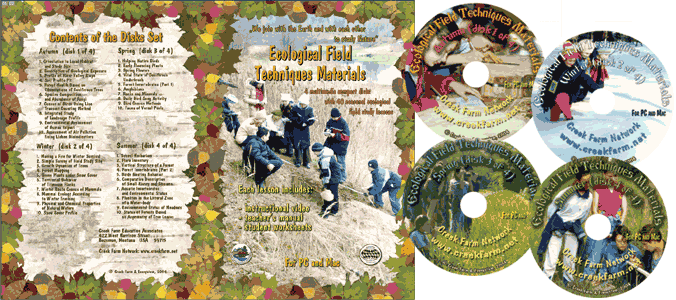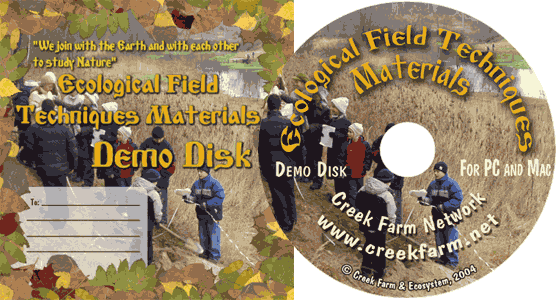|
| Our Field Ecology Center published more than
180 methodical materials for nature studies. Some of them are in English: |
|
|
|
Studies of Species Composition and Abundance of Amphibians
© Alexsander S. Bogolyubov,
Russia, 2002
© Michael J. Brody, USA,
2003
 This manual contains a procedure for the organization of studies of
the numbers and population structure of amphibians in spring and summer. The method of
selecting habitats for study, the technique for a route census of frogs, the procedure for
the simplest measurements of caught animals and the analysis of the age structure of frog
populations found in different biotopes are described. This manual contains a procedure for the organization of studies of
the numbers and population structure of amphibians in spring and summer. The method of
selecting habitats for study, the technique for a route census of frogs, the procedure for
the simplest measurements of caught animals and the analysis of the age structure of frog
populations found in different biotopes are described.
This field study has instructional video
featuring real students conducting the ecological field techniques in nature. Each video
illustrates the primary instructional outcomes and the major steps in accomplishing the
task including reporting the results.
Introduction
If we look at the history and culture of humankind, amphibians as well as reptiles have
always aroused a feeling of suspicious interest and some superstitious fear. In fairy
tales and legends of many peoples of the world, they were the prototypes of dark forces,
evil and danger. Despite all of these superstitions, amphibians are very sensitive,
interesting and unusual animals.
Amphibia is the first and most primitive class of terrestrial vertebrates. Their
fish-like progenitors appeared on Earth in the Devonian period (about 350 million years
ago). In spite of long-term evolution, amphibians kept a number of primitive features,
which they inherited from their ancestors.
Most modern amphibians (which are divided into three orders Ц Apoda, Caudata
and Anura, with a total of 4500 species) are closely connected to life in
the course of their life cycle. They deposit their spawn (eggs) in water, where
development of embryos and larvae takes place. Mature amphibians (most species) spend most
of their life on land. Such a УdoubleФ life, i.e. life in two types of habitats, aquatic
and terrestrial, is reflected in the Latin name of these animals (Amphibia).
Unlike other vertebrates, the skin of Amphibia is smooth Ц there are no scales, feathers
or hair; it is often moist to touch due to numerous glands.
A diversity of amphibians is not found in the northern and temperate climatic zones of
the Earth (most of them are found in the lower, tropical latitudes). Thus, a number of
species found in a specific area does not exceed five to eight for the majority of the
Russian territory. The reason for this is the poikilothermy of amphibians,
i.e. the inconstancy of their body temperature, which greatly depends on the temperature
of their environment. The cold climate of temperate and northern latitudes results in the
fact that not many amphibian species can exist there. That is why it is so interesting to
study amphibians under severe conditions that are almost unsuitable for the existence of
cold-blooded animals. In addition, the low species diversity of amphibians makes the
educational study of these species easier. Besides, these species are not as active and
cautious as other invertebrates, and they can be caught easily in order to examine them
more closely: to measure and weigh them. All these factors greatly contribute to the
possibilities of their study by students.
The study is aimed at an amphibian census carried out within the vicinities of
the school or field studies center. Students catch amphibians and analyze the size and age
structure of their populations in different biotopes of the surrounding area in the course
of conducting the studies. The most favorable period for the given study is the end of
spring and the beginning of summer, i.e. the period of highest activity for amphibians,
their breeding and migrations.
Students will use the following equipment in the course of their studies: containers
for catching frogs (buckets), rulers (slide gauge) for measurements, a laboratory balance,
field diaries and calculators.
Preparation for carrying out the study
At the preparation stage, students should learn about the expected composition of
amphibian species within the specific area and proposed procedures for studies. In order
to do this, it is necessary to make a list of amphibian species in the area using
available atlases, manuals and field guides. Students should also recollect the general
rules for route census, which were taught in previous lessons of the given series (census
of fungi: Lesson #6, fall; bird census: Lesson # 7, fall).
As the research is aimed at studying the species composition, numbers and age
structure of amphibian populations in different biotopes, so it is recommended to
begin by making a list of biotopes under study Ц as it is done during all studies within
the given series on carrying out research on the habitat variability of specific
indicators (Lessons #6, #7, # 10 fall; Lesson#5 winter, Lessons #2, #3, #4, # 10 spring,
Lessons #5, #9 summer).
If this short-term research (1-2 days) is carried out by a small group of students
(10-15 people), then it is recommended to include four or five biotopes (habitats) in the
...
This was only the first page from the manual and its full version you can see in the
Ecological Field Studies Techniques Video 4CD Set:
It is possible to purchase the complete set of 40 seasonal Ecological Field
Studies Techniques Video (in mpg format) in an attractive 4 compact disk set.
These compact disks are compatible with Mac and PC computers.
The videos are suitable for individual student or whole class instruction. To purchase the complete 4CD set
write to ecosystema1994@yandex.ru in a free form.

Ecological Field Studies Demo Disk:
We also have a free and interesting demonstration disk that explains our ecological field studies approach.
The demo disk has short excerpts from all the seasonal field study videos as well as sample text from all the teacher manuals.
The disk has an entertaining automatic walk through which describes the field study approach and explains how field studies meet education standards.
You can also download the Demo Disc from ecosystema.ru/eng/eftm/CD_Demo.iso.
This is a virtual hybrid (for PC and Mac computers) CD-ROM image (one 563 Mb file "CD_Demo.iso").
You can write this image to the CD and use it in your computer in ordinary way.
You also can use emulator software of virtual CD-ROM drive to play the disk directly from your hard disk.

|







